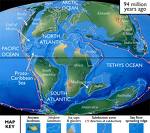The Cretaceous Period 65 - 145 Million Years Ago
Homepage > Age of the Dinosaurs - Cretaceous Period
The Cretaceous Period began 145 million years ago and lasted for 80 million years. The Cretaceous Period follows on the Jurassic Period, and is the youngest period of the Mesozoic Era. The Cretaceous Period defines the boundary between the Mesozoic and Cenozoic eras.
During the Cretaceous Period the Earth possessed warm climate and high eustatic sea levels. North American was essentially cut in half by a shallow sea that extended from present day Hudson Bay to the Gulf of Mexico.
 Western
North America was connected to Eastern Asia, and some groups of dinosaurs
such as the ceratopsians, tyrannosaurids, and pachycephalosaurids were
unique to these two regions.
Western
North America was connected to Eastern Asia, and some groups of dinosaurs
such as the ceratopsians, tyrannosaurids, and pachycephalosaurids were
unique to these two regions.
Nowadays the landmasses of South America, Antarctica, Madagascar, and India may have been closely linked, and all shared several unique groups of dinosaurs such as the titanosaurid sauropods and abelisaurid theropods during the Cretaceous.
During this time Australia was much closer to the South Pole than it is today and would have experienced extended periods of darkness, as Antarctica still does. Dinosaurs are known to have existed in Australia during the Cretaceous.
 The
oceans were populated with now extinct marine reptiles, ammonites and
rudists. Marine reptiles included ichthyosaurus in the early and middle
of the Cretaceous Period, becoming extinct during the late Cretaceous.
The
oceans were populated with now extinct marine reptiles, ammonites and
rudists. Marine reptiles included ichthyosaurus in the early and middle
of the Cretaceous Period, becoming extinct during the late Cretaceous.
Terrestrial animals include mammals but they were still a relatively minor component of the fauna. Early marsupial mammals evolved in the early Cretaceous Period, and true placentals emerged in the late Cretaceous Period. There was a significant shift in the nature of plant eating dinosaur faunas in some parts of the world.
 Long
necked sauropods continue to be diverse early in the Cretaceous, but the
numbers of this huge dinosaurs declined later throughout the period. During
the late Cretaceous, the dominance in the northern continents had shifted
to the ornithopods and ceratopsians. This later group of horned animals
was among the last groups of dinosaurs to evolve.
Long
necked sauropods continue to be diverse early in the Cretaceous, but the
numbers of this huge dinosaurs declined later throughout the period. During
the late Cretaceous, the dominance in the northern continents had shifted
to the ornithopods and ceratopsians. This later group of horned animals
was among the last groups of dinosaurs to evolve.
In China, we find numerous types of small dinosaurs, birds, and mammals. The coelurosaur dinosaurs found there represent types of the group Maniraptora, which is the transition between dinosaurs and birds, they are identifiable for the presence of hair-like feathers.
Also during the Cretaceous Period, we find a diversification of insects, such as ants, termites, butterflies, moths, and grasshoppers.
At the end of the Cretaceous Period, important changes were occurring around the globe that would dramatically affect life on earth. Sea levels were dropping and temperatures everywhere were lowering slightly. Parts of the planet were experiencing extensive volcanic activity.
 But
perhaps the most significant of all however, was the single extraterrestrial
cataclysmic event. A large asteroid that collided with Earth, with devastating
consequences.
But
perhaps the most significant of all however, was the single extraterrestrial
cataclysmic event. A large asteroid that collided with Earth, with devastating
consequences.
During the end of the Cretaceous Period more than half of the world's animals, including all of the Mesozoic dinosaurs, diet out. Researchers believe that any or all of these phenomena may have played a role in the major extinctions that occurred during this time.